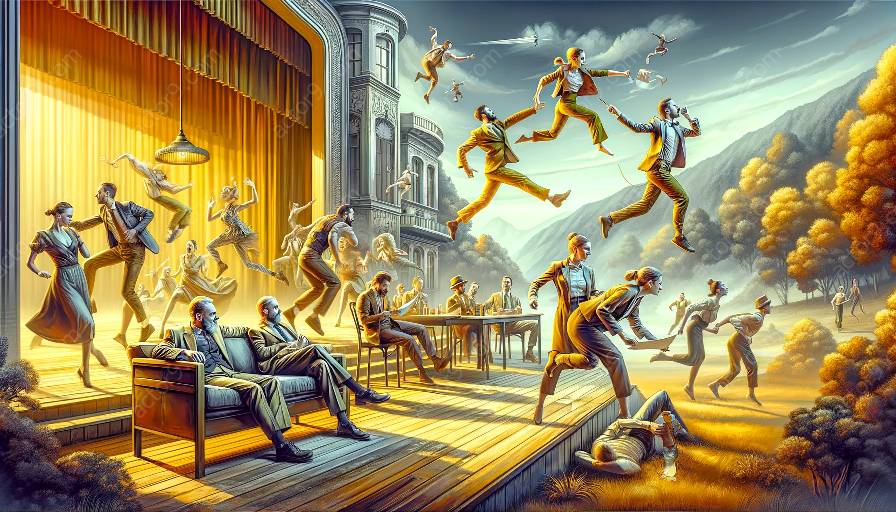Physical theatre is a captivating and expressive form of performance art that seamlessly integrates the use of the body to convey stories, emotions, and ideas. When it comes to comedic aspects of physical theatre, the art of timing and rhythm takes center stage. In this topic cluster, we will delve into the intricacies of timing and rhythm in physical theatre, specifically focusing on creating comic effects. This exploration will provide a deeper understanding of how physicality and expressiveness play a crucial role in engaging and entertaining audiences through laughter and amusement.
The Essence of Physical Theatre
Before delving into the specifics of comedic timing and rhythm, it's important to appreciate the essence of physical theatre itself. Physical theatre is a dynamic and versatile art form that emphasizes the use of the body as the primary means of storytelling. Unlike traditional theatre, physical theatre relies on movement, gesture, and expression to convey narratives and evoke emotions.
Through a combination of mime, dance, acrobatics, and other physical techniques, performers engage in a visually stimulating and impactful form of storytelling. The physicality inherent in this art form allows for a deeper connection with the audience, as the body becomes a powerful vehicle for communication and expression.
Comedic Aspects of Physical Theatre
Comedy has been an integral part of theatrical performances throughout history, and physical theatre is no exception. The ability to elicit laughter and amusement through physical means is a skill that requires a keen understanding of timing, rhythm, and expressiveness.
Comedic aspects of physical theatre encompass a wide range of techniques and approaches, including slapstick, clowning, physical humor, and farce. These comedic elements often rely on precise timing and rhythmic patterns to deliver punchlines, create comedic situations, and engage the audience in laughter.
The Art of Timing
Timing is a fundamental aspect of comedic performance in physical theatre. It involves the precise execution of movements, gestures, and verbal cues to generate comedic effects. Effective timing requires a keen sense of rhythm, pacing, and anticipation to deliver punchlines and comedic gestures at the most opportune moments.
Timing in physical theatre is like a carefully orchestrated dance, where performers must synchronize their movements with precision to elicit laughter and amusement from the audience. Whether it's a well-timed pratfall, a perfectly executed sight gag, or a comedic pause, mastering the art of timing is essential for creating memorable comic moments.
The Rhythm of Physical Comedy
Rhythm is intricately woven into the fabric of physical comedy in theatre. It encompasses the cadence, tempo, and flow of movements, gestures, and interactions that contribute to comedic effects. Just as in music, comedic rhythm in physical theatre involves variations in speed, pauses, and accents to build comedic tension and release.
Understanding the rhythm of physical comedy allows performers to play with pacing, create unexpected twists, and punctuate comedic moments with precision. Whether it's the rapid-fire exchange of physical gags or the deliberate build-up to a hilarious payoff, mastering comedic rhythm adds depth and impact to the comic aspects of physical theatre.
Creating Memorable Comic Effects
By integrating the art of timing and rhythm into their performances, physical theatre practitioners can create memorable comic effects that leave a lasting impression on audiences. The key lies in the synergy between timing, rhythm, and expressiveness to craft scenes and sequences that resonate with humor and delight.
Through meticulous rehearsal and exploration, performers can refine their comedic timing and rhythm to maximize comedic impact. This involves experimenting with variations in timing, exploring different rhythmic patterns, and honing the expressiveness of their physical gestures to amplify comedic effects.
Engaging and Entertaining Audiences
Ultimately, the art of timing and rhythm in physical theatre serves the purpose of captivating and entertaining audiences. The seamless integration of comedic aspects into physical performances adds an extra layer of enjoyment and engagement for spectators. The ability to elicit genuine laughter and amusement through physical storytelling is a testament to the power of timing and rhythm in creating compelling comic effects.
By mastering the art of timing and rhythm, performers in physical theatre can connect with audiences on a profound level, transcending language barriers and cultural differences through the universal language of humor. The result is a shared experience of joy and laughter, making physical theatre an enriching and unforgettable form of entertainment.




































